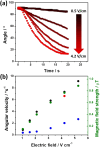Exogenous chemically-driven electromagnets
- PMID: 40556729
- PMCID: PMC12184687
- DOI: 10.1039/d5sc00911a
Exogenous chemically-driven electromagnets
Abstract
Magnetically-driven dynamic systems have gained considerable attention in multiple applications ranging from cargo delivery to environmental remediation. However, they commonly require ferromagnetic components or sophisticated electromagnetic equipment. In this work we take advantage of the synergy between exogenous bipolar electrochemistry and the classic geometry of a solenoid in order to design an externally driven chemo-electromagnet. By wirelessly triggering redox reactions at each extremity of a solenoid-shaped swimmer, the generated electric current follows the helical path of the coil, thus generating a concentric magnetic field in its center. Such an externally induced redox current generates magnetic fields in the range of μT which are proportional to the applied electric field. The on-board chemically induced magnetic dipole allows the swimmers to perform rotational motion in the presence of an external magnetic field, without the use of traditional ferromagnetic materials. Additionally, when exposing these devices to alternating electric and magnetic fields, well-defined oscillatory motion is produced, demonstrating the efficient electromagnetic control of the dynamic displacement. This opens up novel and, so far, unexplored possibilities for localized chemical conversion via magnetically-driven "chemistry on-the-fly".
This journal is © The Royal Society of Chemistry.
Conflict of interest statement
There are no conflicts to declare.
Figures




References
LinkOut - more resources
Full Text Sources

